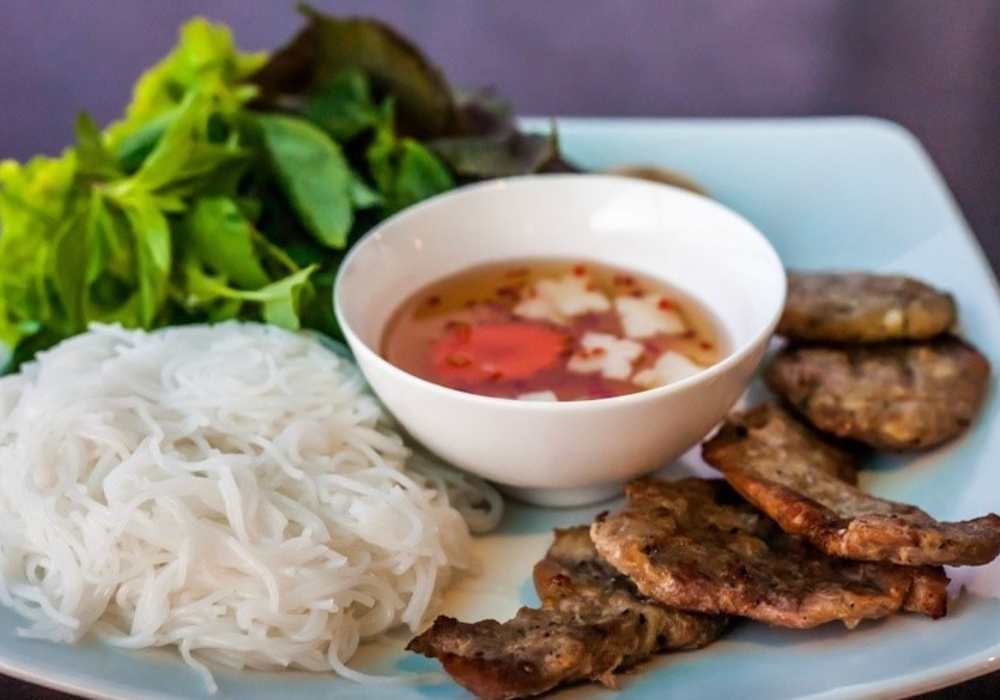
Vietnamese Bun Cha: The Exquisite Fusion of Flavors
The story and origins of Vietnamese Bun Cha
Vietnamese Bun Cha is a beloved Vietnamese dish, has a fascinating story and rich cultural origins. It originated in Hanoi, the capital city of Vietnam, and has become an iconic representation of the country’s culinary heritage. The roots of Vietnamese Bun Cha can be traced back to the simple and authentic lifestyle of the Hanoi people, who have contributed to the development of its unique flavors.

Overview of Vietnamese Bun Cha
Vietnamese Bun Cha is a popular Vietnamese dish that originated in Hanoi, the capital city of Vietnam. It is a flavorful and satisfying meal that showcases the essence of Vietnamese cuisine.
At its core, Bun Cha consists of three main components: grilled pork, rice vermicelli noodles (bun), and a dipping sauce. The dish is typically accompanied by a side of fresh herbs and vegetables.
The grilled pork is the highlight of Bun Cha. Thinly sliced pork, often marinated in a combination of garlic, sugar, fish sauce, and other spices, is grilled over charcoal or wood fire. The grilling process imparts a smoky and charred flavor to the meat, creating a delightful contrast between the tender interior and crispy edges.
Rice vermicelli noodles, known as bun, serve as the base of the dish. These thin, translucent noodles are cooked until they are soft yet slightly chewy. The noodles act as a neutral canvas to absorb the flavors of the grilled pork and the dipping sauce.
The dipping sauce is a crucial element that ties all the flavors together. It is typically made from fish sauce, sugar, lime juice, minced garlic, and chili. The sauce adds a savory and tangy element, enhancing the taste of the grilled pork and infusing the noodles with its rich flavors.
To complete the dish, Vietnamese Bun Cha is served with a side of fresh herbs and vegetables. Aromatic herbs such as mint, Thai basil, and cilantro provide a burst of freshness and fragrance. Lettuce leaves add a crisp and refreshing texture. Additionally, pickled carrots and green papaya offer a tangy and slightly sweet flavor that balances the richness of the pork and adds a delightful contrast to the dish.

>>> See more: 5 place to eat in Hanoi that you have to try once in your life!
Ingredients and Preparation Process
The essential elements of Bun Cha
Bun Cha consists of high-quality ingredients including fresh pork, fish sauce, rice vermicelli noodles, and a variety of fresh vegetables. The pork is carefully selected, with a balanced ratio of lean meat and fat to ensure its tenderness and flavor. The fish sauce is made from high-quality fish sauce, combined with sugar, garlic, chili, and other natural spices. The rice vermicelli noodles are made from rice and have a pleasing chewy texture.
Preparation and cooking process of Vietnamese Bun Cha
To create a perfect Bun Cha, the preparation and cooking process require meticulous attention to detail.
- Preparing the pork and fish sauce: The pork is thinly sliced and marinated with a mixture of garlic, salt, sugar, and other spices. The fish sauce is prepared by combining fish sauce, sugar, lime juice, and minced garlic.
- Marinating and grilling the pork: The marinated pork is left to soak in the flavors for a specific period of time. It is then grilled over charcoal or wood fire until cooked and beautifully golden.
- Steps to prepare the dipping sauce and broth: The dipping sauce is created by blending fish sauce, sugar, water, vinegar, and minced garlic. The broth is made by simmering pork bones, spices, and the diluted fish sauce.
- Crafting the diluted fish sauce and ginger fish sauce: The diluted fish sauce is prepared by combining fish sauce, sugar, water, and lime juice. The ginger fish sauce is made by adding grated ginger, garlic, sugar, and vinegar to fish sauce.
- Cooking the vermicelli noodles and preparing the fresh vegetables: The vermicelli noodles are boiled until cooked and then rinsed with cold water to maintain their chewy texture. The fresh vegetables are prepared by cutting them into small pieces to add to the Bun Cha bowl.
Enjoying Vietnamese Bun Cha
Techniques for eating and combining the components
When enjoying Bun Cha, there are various ways to savor the dish. You can choose to dip the grilled pork and noodles into the diluted fish sauce or the ginger fish sauce to enhance the flavors. The fresh herbs and vegetables can be added to the bowl to provide freshness and a delightful crunch.
Recommended types of fish sauce and condiments
There are different types of fish sauce and condiments that can be used to accompany Bun Cha. The diluted fish sauce and ginger fish sauce are popular choices. Additional condiments such as minced garlic, chili, black pepper, and pickled vegetables can be added to customize the flavors according to personal preference.
Accompanying fresh vegetables and fruits
Fresh vegetables and fruits play a crucial role in complementing the flavors of Bun Cha. A variety of herbs like perilla leaves, Vietnamese coriander, lettuce, and mint can be added to the dish. Additionally, pickled carrots, green papaya, cucumber, and sliced chili peppers can provide a tangy and refreshing contrast.

Other Traditional Vietnamese Dishes
Recap of the experience of enjoying Vietnamese Bun Cha and its cultural significance Indulging in the flavors of Bun Cha is not only a gastronomic delight but also an opportunity to immerse oneself in Vietnamese culture. The harmonious blend of grilled pork, fish sauce, and fresh ingredients showcases the simplicity and authenticity of Vietnamese cuisine. Suggestions for exploring other traditional dishes In addition to Bun Cha, Vietnam offers a wide array of traditional dishes worth exploring. Some examples include Pho (noodle soup), Banh Mi (Vietnamese sandwich), Nem Ran (fried spring rolls), Com Tam (broken rice), and many more. These dishes will further enrich your knowledge of Vietnamese cuisine. Bun Cha, with its unique and exquisite flavors, represents the essence of Vietnamese culinary art. Enjoying this iconic dish is an experience that reveals the cultural richness and culinary expertise of Vietnam.


